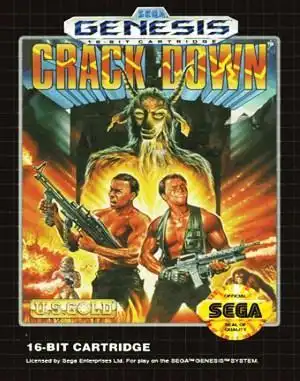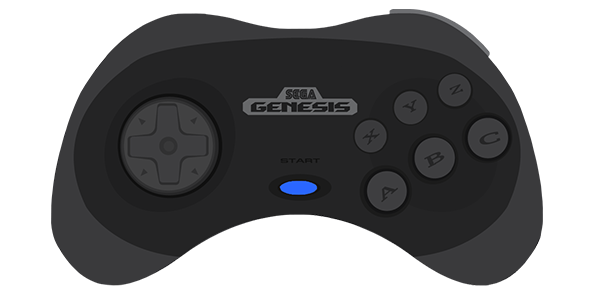Stepping back into the 16-bit era brings up memories of iconic platformers, speedy racers, and intense shooters. But sometimes, you stumble upon a game that was a little... different. Sega's own Crack Down Sega Genesis port fits that bill perfectly – a unique top-down action title that blended shooting with a surprising amount of tactical movement.
While maybe not as instantly famous as Sonic or Street Fighter II on the console, Crack Down offered a distinct arcade experience that found a comfortable home on Sega Genesis. Let's revisit this curious title and see why the Genesis version is often considered the one to play.
What Exactly is Crack Down?
Originally an arcade hit from Sega in 1989, Crack Down puts you in the shoes of super agents Ben and Andy. Your mission: stop the nefarious Mr. X and his army of cyborgs who are threatening world peace. The game unfolds from a top-down perspective, showing the entire level layout on screen.
The core gameplay loop involves navigating labyrinthine levels, planting time bombs at designated spots, and then making a hasty exit before they detonate. You'll face off against various robotic foes, security systems, and the ever-present ticking clock. It's less about running-and-gunning everything in sight and more about careful movement, timing, and using your limited resources wisely.
The Genesis Port: Why It's the One to Seek Out
Crack Down saw ports to numerous home computers and consoles back in the day, but the Sega Genesis version holds a special place, often cited by retro enthusiasts as the most polished and playable home conversion.
Here's why the Genesis port shines:
- Smoother Gameplay: Compared to many janky computer ports (looking at you, Amiga/ST with your bugs!), the Genesis version generally offers a more stable and responsive experience. Movement feels better, and you're less likely to get stuck on scenery or enemies.
- Useful Features: The Genesis controller layout allowed for a dedicated weapon select button, a small but significant quality-of-life improvement over versions that required complex key combinations or awkward toggles. Difficulty options were also a welcome addition.
- Better Handling of Mechanics: The game's signature "wall-hugging" move, useful for peeking around corners or avoiding fire, felt more reliable on the Genesis than in some other ports where it could be buggy or ineffective.
- Solid Presentation: While maybe not pushing the Genesis hardware to its absolute limit, the graphics and sound were faithful to the arcade original, capturing the game's industrial, slightly claustrophobic atmosphere. The sound effects, including digitized voices, were a highlight and closer to the arcade than many ports.
Sure, the Genesis version wasn't perfect – it could suffer from slowdown when the action got particularly hectic – but its overall playability and lack of game-breaking bugs made it the definitive home experience for many.
Blasting Through Levels, One Bomb at a Time
Each stage in Crack Down is a race against the clock. You enter, scope out the map (which is always visible, a great feature!), plan your route, plant the required bombs, and get out before time expires or the bombs blow up prematurely.
- Split-Screen Action: Even in single-player, the screen is split vertically. This was a carryover from the arcade's mandatory two-player setup. While odd at first for solo play, it adds to the game's unique visual identity.
- Enemies & Obstacles: You'll encounter stationary turrets, patrolling robots, and later, tougher cyborgs. Levels are also filled with traps like laser grids, conveyor belts, and force fields that require careful timing to navigate.
- Weapons & Bombs: You start with a basic gun but can collect better firepower. The main objective, though, revolves around those bombs. Planting them requires standing in a specific spot and waiting, adding a moment of vulnerability and tension.
The difficulty ramps up steadily, forcing you to master the movement, shooting, and timing mechanics. It's a game that rewards patience and observation rather than brute force.
Reliving the Stealthy Action Today
Feeling nostalgic for some top-down Genesis action? While physical cartridges can still be found on the secondary market, the most accessible way to play Crack Down on Sega Genesis today is through emulation.
Genesis emulators are readily available for PC, Mac, and even modern single-board computers. You can also find the Genesis version of Crack Down preserved on platforms like the Internet Archive, often playable directly in your web browser, offering a taste of that retro goodness without needing specialized software.
It's a great way to experience a game that offered something a bit different from the typical Genesis fare and appreciate why the console port was a standout among its many siblings.
Final Verdict
Crack Down on the Sega Genesis is a fascinating relic of the late 80s arcade scene. It's a game that requires a different mindset than many of its contemporaries, blending action with puzzle-like navigation and timed objectives. While perhaps not a household name, its unique gameplay and the quality of the Genesis port make it a worthwhile visit for any retro gamer looking to explore the console's deeper library. If you missed it back then, or only played an inferior computer version, give the Genesis port a shot – you might just find a new old favorite.
Crack Down Sega Genesis FAQ
What genre is Crack Down?
Crack Down is primarily a top-down action game with elements of stealth and puzzle-solving, focusing on timed objectives and careful navigation.
Is Crack Down on Sega Genesis a 2-player game?
Yes, the Sega Genesis version retains the split-screen co-op multiplayer from the arcade, allowing two players to team up as agents Ben and Andy.
How does the Genesis version compare to other ports?
Many retro enthusiasts consider the Sega Genesis port to be one of the best, if not the best, home conversions of the arcade original, offering smoother gameplay, fewer bugs, and useful features compared to many computer ports.
Can I play Crack Down on Sega Genesis today?
Yes, you can play the game today through emulation on various platforms (PC, Mac, etc.) or via browser-based emulators available on sites like the Internet Archive.


